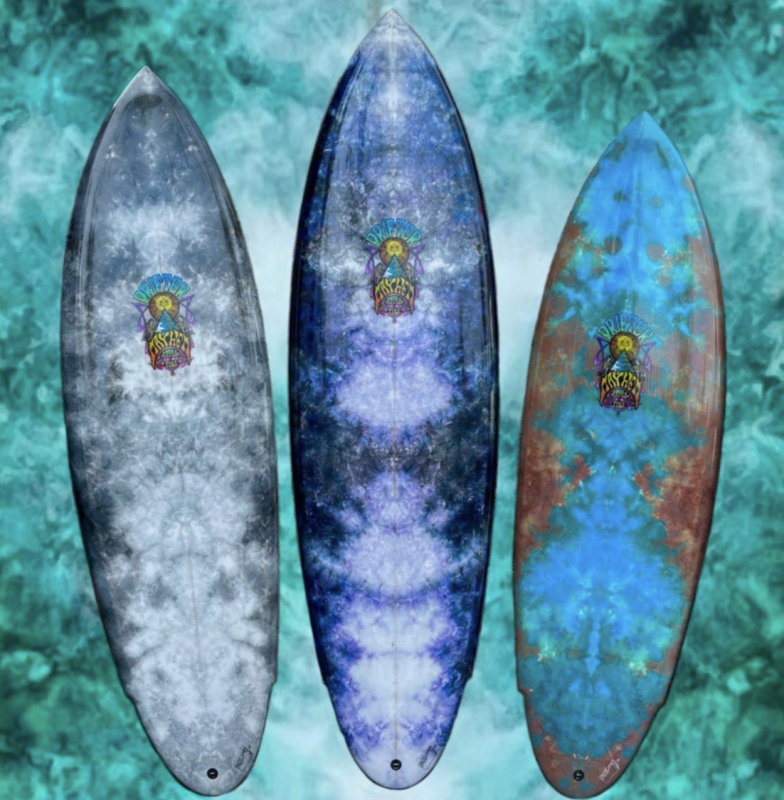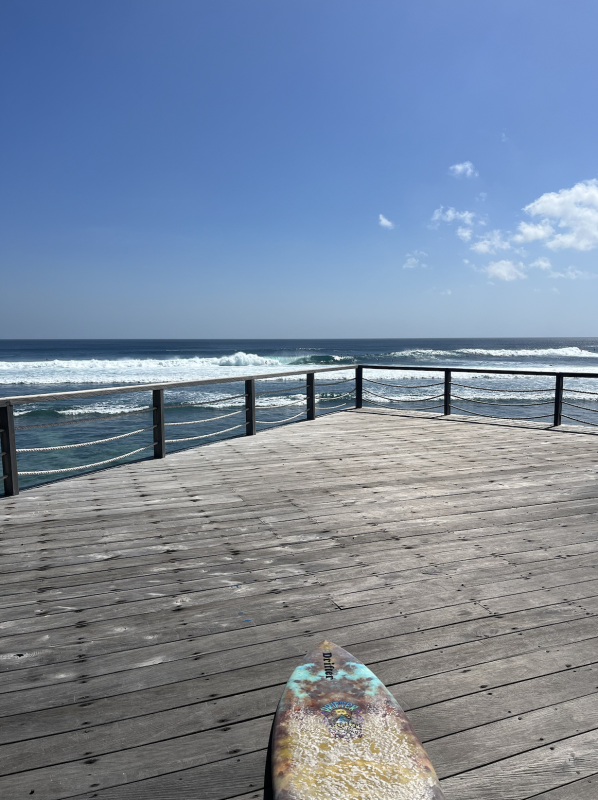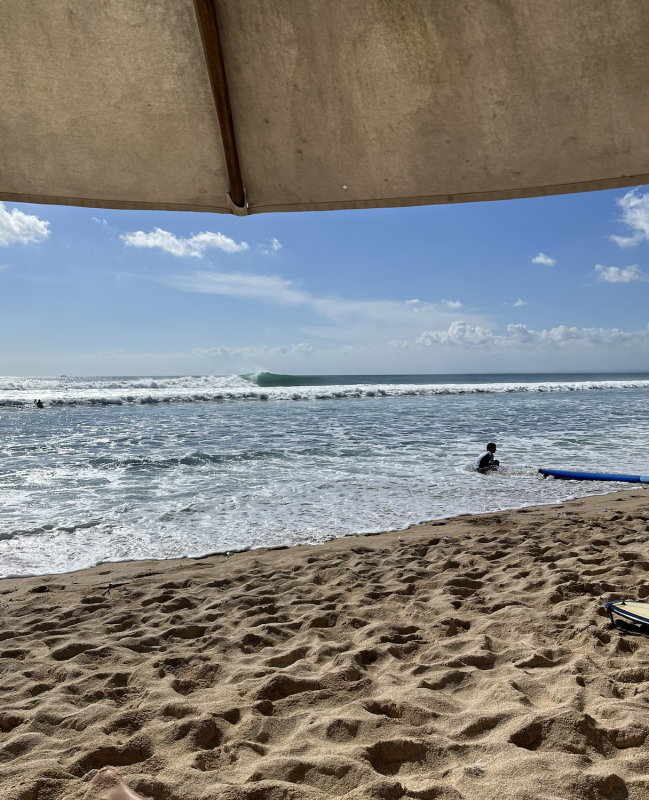
Mayhem x Drifter
Up until the early 2000s, when the waves in Indonesia grew in size, so did the surfboards. Take this clip of the 1997 Quiksilver Pro at firing G-Land for example. Everyone in the comp that year was riding boards that were around seven feet long.
In recent years, however, surfers have been experimenting with riding smaller and/or “fishier” boards in big surf. The idea being if you can hide the volume in a shorter, flatter board, but get the shape, bottom contours and fin setup just right, you can build a board that catches waves as easily as a step-up, but performs even better, both on the face and in the barrel.
With that in mind, Matt Biolos and the crew at Drifter Surf decided to collaborate on a surfboard model designed specifically for the waves in and around Bali.
“We spent a lot of time surfing Temples and around the Bukit, with the Drifter crew, over the last decade,” Biolos told us, when we asked about the inspiration behind building this very niche model. “Fish type boards feel great, but sometimes get a bit squirmy, even on smaller days. You wanna really push hard with confidence, but even the best-designed swallow tails don’t always feel solid under foot.”
Related: Watch: This Is the Best Surfboard Advertisement We’ve Ever Seen
On the specifics, Biolos continues: “Starting with our RetroFish, and replacing the swallow tail with a pin, then pulling in the overall widths, we strived to created a specialized board, built specifically for ‘fishing’ in Balinese barrels. Short, fast and fun, but still holds. To add to it, the art direction netted a graphic locally inspired logo and Indonesian, batik style, tie dye colors.”
With the Indian Ocean season in full swing, I decided to grab one off the rack from Drifter and to review in serious Bali juice. So: How did it go?
Pin Fish Specs
Dimensions: 5’7″ x 19.75″ x 2.38″
Liters: 29.5L
Cost: Click here for more info
Testing The Pin Fish Day 1: Uluwatu
If you read my review of the Channel Islands Dumpster Diver 2, you know I’m (mostly) a standard shortboard guy, so the Pin Fish is a huge deviation from the norm for me. I’m 5’9″ and 150 pounds, and I ride shortboards around 26 liters. The Pin Fish I rode was 5’7″ x 19.75″ x 2.38″, with a volume of 29.5L. Size wise, it’s right in line with my shortboards, but with a much flatter outline, and a lot more foam.
As I jumped to my feet on the very first wave that swung to me at 4-foot Temples, I tried to yank hard on my outside rail and slide into the tube backside, but my quad fins never engaged, so I dropped into oblivion while the wave rifled off without me. Total fail. But, the board wasn’t designed for knifing late drops, so I chalked it up to user error.
After paddling back out and resetting expectations, I sat further out, waited for sets, and rolled in to them early. While I sorta outraced the first few waves while I was trying to figure out my feet placement, I was totally blown away by how fast the board was on a straight line. And paddling into them, it felt like I was riding a board at least a foot longer.
While it took me a half dozen waves before I had the board kinda figured out, once I started to capture (versus try to create) speed, I was able to dial the board in. The pulled-in wing tail let me to drive off the bottom without sliding, and I could also hold my rail through a backside carve. I even turned the board tight up into the lip on a couple of smaller, bowlier lefts, as long as my back foot was set way back on the tail block. My only complaint after a 2 hour surf? I really wish I was a goofy foot.

Testing The Pin Fish Day 2: Keramas
Like Biolos mentioned above, the Pin Fish was designed for Uluwatu’s Bukit Peninsula, plus nearby waves like G-land and Desert Point. But, I’m a regular foot, so I had to ride it going right once.
Keramas was smaller and less hollow than I would have liked, and the crowd was also really thick. The great thing about riding a board with so much volume is it paddles like a dream. Being able to sit a little further out and catch waves early is a total life hack in a crowded lineup, as it’s a lot harder for someone to burn you when you’re already riding a wave.
The extra volume at Keramas was both a blessing and a curse. While I was able to catch more waves than normal, the Pin Fish wasn’t designed for a tight, bowly wave. Keramas is not Uluwatu, and the Pin Fish is so fast I was having a tough time fitting it in the curve of the wave. I did manage to get one set from deep that allowed me to backdoor a barrel, and the board felt like a dream in the tube. I did one little pump and held my line while the Pin Fish steamrolled the foam ball. I could only imagine what it would feel like if I were a goofy at Desert Point. It might just be the ultimate crowd beater/tube wrangler at a wave like that.

Testing The Pin Fish Day 3: Balangan
While Balangan is not Uluwatu, it’s still a picturesque lefthander, with a mellower crowd than Ulu’s. With a new swell showing, I wanted to get the board in a longer, softer wave than Temples, to see how it would feel specifically on the face.
On my first few waves, while the board was really fast, it was a little clunky rail to rail whenever the wave face went flat. That’s partly because the board has a tad more foam than I would have liked, but it’s also by design. Like Biolos said, the board is built mainly for “fishing” inside of Bali tubes, rather than ripping a soft face. (Note: I rode the board exclusively as a quad, but it can be setup as a thruster, too. That would allow a little more rail-to-rail freedom, though it would also sacrifice speed.)
An hour in and I took off on a wide medium set, with the long 4-foot wall wrapping the bottom half of the reef perfectly. After two high line speed checks, I hit the brakes with my hip and slotted into the most idyllic backside tube I could ever ask for. Like I’d experienced at Keramas, the board felt like a locomotive in the tube, and when I locked in my line, I had no problem keeping my speed. I snuck out just before the end section hit dry reef. The best wave I’ve ever had out there, by far.

The Verdict: The Pin Fish?
It’s obvious Biolos and the crew at Drifter looked to Uluwatu, then thought about the way legendary surfers like Gerry Lopez, Rizal Tandjung and Rob Machado approach it, and designed a board that would perfectly suit that combo.
And they nailed it.
From the shape to the logo to the color palette, The Pin Fish honors Bali beautifully. And best of all, it works in her waves.
Only available as a custom shape in Bali, it’s a board to order before your next visit, ride as much as possible when the waves are pumping, and then bring back home. It’s a board that’ll look just as beautiful hanging on your wall as it does streaking through tubes on the Bukit and beyond.
Related: The Dumpster Diver 2 Was Built for Better Surf. Should You Buy It?

